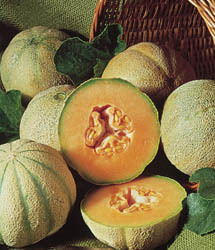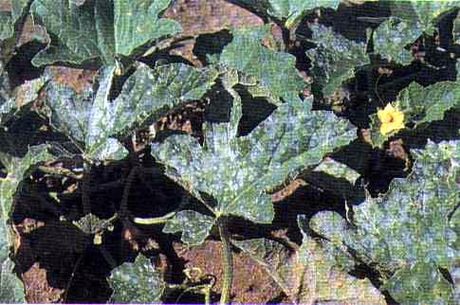 Powdery mildew is one of the most serious fungal disease of melon. It can reduce yield (fruit quantity and size) and market quality (flavor, color, and storability).
Powdery mildew is one of the most serious fungal disease of melon. It can reduce yield (fruit quantity and size) and market quality (flavor, color, and storability).Controlling powdery mildew in melon is critical because it is fundamental to ensure leaves remain healthy until fruit mature and obtain high sugar content resulting suitable to be marketable. Choosing powdery mildew-resistant varieties is an effective tool to control and manage the disease.
However, the fungus is quick in overcoming the genetic resistances producing new races, thus every few years new resistant varieties are released providing growers with information about the performance (disease suppression, yield and fruit quality) of these varieties under local conditions.
In 2008, the researchers of Cornell University, McGrath and Menasha, compared 9 varieties of cantaloupe melon: "Hannah’s Choice", "Strike", "Athena", "Wrangler", "Halona", "Pixie", "Sarah’s Choice", "Eclipse", "Superstar". The leaf examination was carried out from 22 July to 15 August just before the first harvest. The authors evaluated the powdery mildew severity on both leaf surfaces (upper and lower), the production of marketable fruits (fruit number/plant and fruit weight/plant) and unmarketable fruits (fruit number/plant), fruit quality (size, seed cavity, flesh color, °Brix, taste, ribbing and netting).

Powdery mildew on Cantalupo leaves.
The varieties "Hannah’s Choice", "Strike", "Athena", "Wrangler", "Halona" resulted the most resistant to the powdery mildew, on which the disease severity was lower than 0.6% on 15 August. Among these,"Wrangler" had the greatest yield with 2-3 marketable fruits per plant for a weight of 4.0 kg per plant. "Strike" had the highest taste rating and one of the highest °Brix values (9.22 °Brix). "Superstar" resulted the least resistant to the pathogen, the fruit production and quality were seriously compromised.
From experimentation results, the researchers have recommended the fungicides application at the first sign of powdery mildew. The fungicides application should be started when examining both surface of at least 50 leaves each week one leaf is affected. The treatment should be made also on resistant varieties, and for the organic productions sulphur compounds and vegetables oils should be used.
Original Study. McGrath M.T., Menasha S., "Resistant Melon Varieties Continue to Provide Excellent Control of Powdery Mildew and Quality Fruit", 2009, Cornell University. For more details: http://www.vegetables.cornell.edu/crops/PMR%20Melon%20evaluation%20081.pdf

